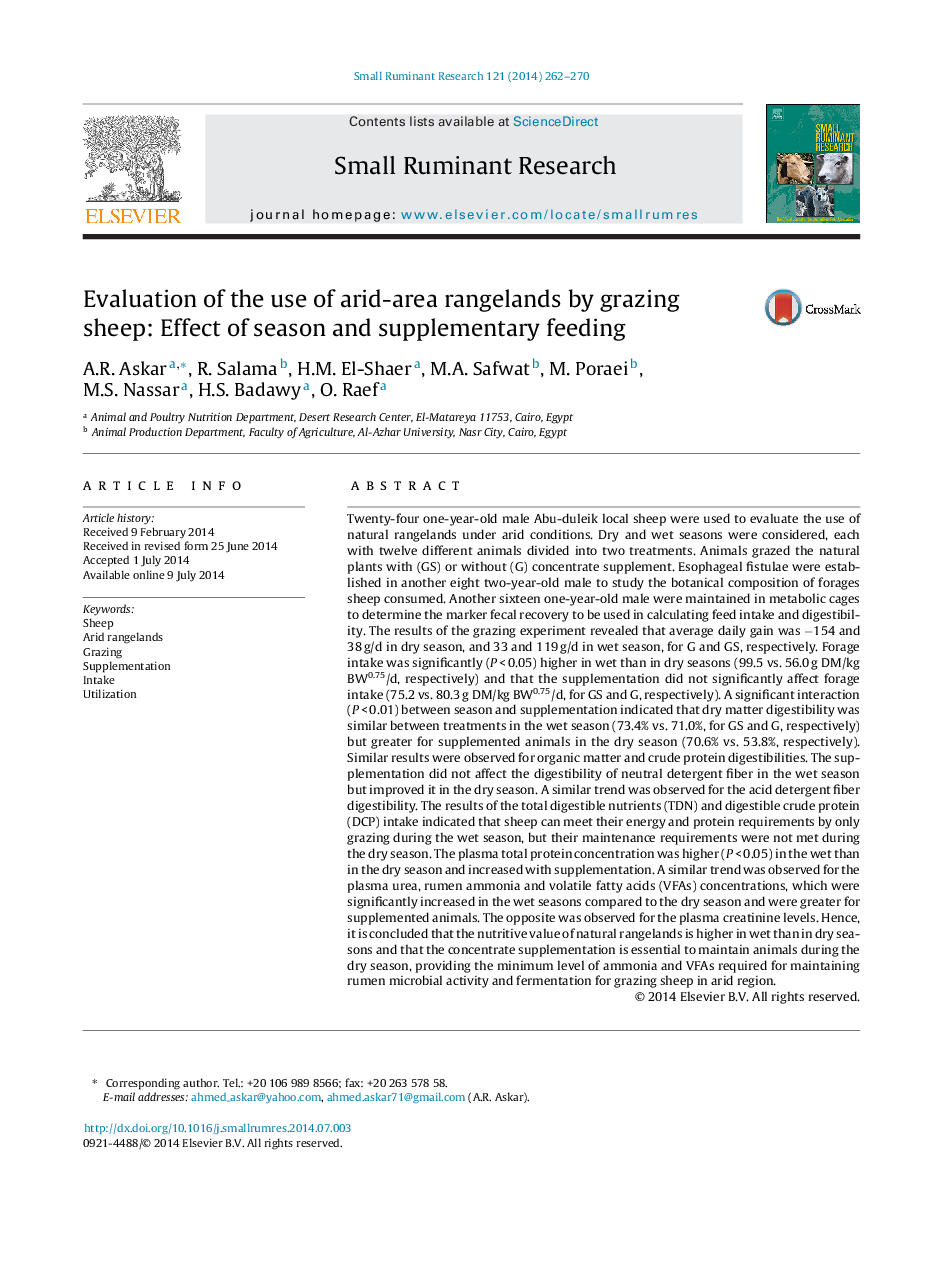| کد مقاله | کد نشریه | سال انتشار | مقاله انگلیسی | نسخه تمام متن |
|---|---|---|---|---|
| 5795555 | 1554371 | 2014 | 9 صفحه PDF | دانلود رایگان |
- Nutritive value of natural arid rangelands is higher in the wet than in dry season.
- Supplementary feeding is essential to maintain animals during the dry season.
- Concentrate supplement improved forage utilization by increasing the digestibility.
- Supplement is necessary to provide the minimum NH3-N and VFAs required for rumen activity.
Twenty-four one-year-old male Abu-duleik local sheep were used to evaluate the use of natural rangelands under arid conditions. Dry and wet seasons were considered, each with twelve different animals divided into two treatments. Animals grazed the natural plants with (GS) or without (G) concentrate supplement. Esophageal fistulae were established in another eight two-year-old male to study the botanical composition of forages sheep consumed. Another sixteen one-year-old male were maintained in metabolic cages to determine the marker fecal recovery to be used in calculating feed intake and digestibility. The results of the grazing experiment revealed that average daily gain was â154 and 38Â g/d in dry season, and 33 and 119Â g/d in wet season, for G and GS, respectively. Forage intake was significantly (PÂ <Â 0.05) higher in wet than in dry seasons (99.5 vs. 56.0Â g DM/kg BW0.75/d, respectively) and that the supplementation did not significantly affect forage intake (75.2 vs. 80.3Â g DM/kg BW0.75/d, for GS and G, respectively). A significant interaction (PÂ <Â 0.01) between season and supplementation indicated that dry matter digestibility was similar between treatments in the wet season (73.4% vs. 71.0%, for GS and G, respectively) but greater for supplemented animals in the dry season (70.6% vs. 53.8%, respectively). Similar results were observed for organic matter and crude protein digestibilities. The supplementation did not affect the digestibility of neutral detergent fiber in the wet season but improved it in the dry season. A similar trend was observed for the acid detergent fiber digestibility. The results of the total digestible nutrients (TDN) and digestible crude protein (DCP) intake indicated that sheep can meet their energy and protein requirements by only grazing during the wet season, but their maintenance requirements were not met during the dry season. The plasma total protein concentration was higher (PÂ <Â 0.05) in the wet than in the dry season and increased with supplementation. A similar trend was observed for the plasma urea, rumen ammonia and volatile fatty acids (VFAs) concentrations, which were significantly increased in the wet seasons compared to the dry season and were greater for supplemented animals. The opposite was observed for the plasma creatinine levels. Hence, it is concluded that the nutritive value of natural rangelands is higher in wet than in dry seasons and that the concentrate supplementation is essential to maintain animals during the dry season, providing the minimum level of ammonia and VFAs required for maintaining rumen microbial activity and fermentation for grazing sheep in arid region.
Journal: Small Ruminant Research - Volume 121, Issues 2â3, October 2014, Pages 262-270
